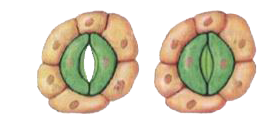What is the role of ions in the opening of stomata?
Step-by-Step Solution:
1. Understanding Stomata: Stomata are small openings on the surface of leaves that facilitate gas exchange and transpiration (the process of water vapor loss from the plant).
2. Role of Guard Cells: Each stoma is surrounded by a pair of specialized cells called guard cells. These cells control the opening and closing of the stomata.
3. Potassium Ion Influx: When potassium ions (K⁺) enter the guard cells, it increases the concentration of solutes within these cells. This influx of K⁺ ions is crucial for the process.
4. Water Movement: As the concentration of solutes (K⁺ ions) increases inside the guard cells, water follows by osmosis. Water moves into the guard cells to balance the solute concentration, leading to an increase in turgor pressure.
5. Turgidity and Stomatal Opening: The increased turgor pressure in the guard cells causes them to swell and become turgid. As a result, the stomata open, allowing for gas exchange and transpiration to occur.
6. Potassium Ion Efflux: Conversely, when potassium ions exit the guard cells, the concentration of solutes decreases. This leads to a decrease in turgor pressure as water moves out of the guard cells.
7. Flaccidity and Stomatal Closure: The loss of water from the guard cells causes them to become flaccid. When the guard cells are flaccid, the stomata close, reducing gas exchange and transpiration.
8. Conclusion: In summary, potassium ions play a critical role in the opening and closing of stomata by influencing the turgidity of guard cells through osmotic changes.
Topper's Solved these Questions
- BOOK - MODERN PUBLICATIONCHAPTER - TRANSPORT IN PLANTSEXERCISE - REVISION EXERCISES (LONG ANSWER QUESTIONS)10videos
TRANSPORT IN PLANTS
- BOOK - MODERN PUBLICATIONCHAPTER - TRANSPORT IN PLANTSEXERCISE - COMPETITION FILE (MULTIPLE CHOICE QUESTIONS)68videos
TRANSPORT IN PLANTS
- BOOK - MODERN PUBLICATIONCHAPTER - TRANSPORT IN PLANTSEXERCISE - REVISION EXERCISES (VERY SHORT ANSWER QUESTIONS)26videos
TRANSPORT IN PLANTS
- BOOK - MODERN PUBLICATIONCHAPTER - THE LIVING WORLDEXERCISE - Chapter Practice Test16videos
THE LIVING WORLD
Similar Questions
Knowledge Check
- Question 1 - Select One
What causes opening of stomata
AThin wall of guard cell facing stomatal pore is stretched more, curves in and pore opensBThick wall of guard cell facing stomatal pore is stretched more, moves in and pore opensCAs thin wall of guard cell is stratched less, the guard cell well facing the stomatal pore moves in and pore opensDThick wall of guard cell facing the stomatal pore is stretched less, moves in and the pore opens. - Question 2 - Select One
Which of the following conditions help in opening of stomata ?
ADarkness, pH-2, high CO2 conenctrationBpH-7, low CO2 concentration and lightCpH-5, low CO2 concentration and darkDHigh CO2 concentration, low K+ ion concentration in guard cells - Question 3 - Select One
Glycolate induces opening of stomata in
APresence of oxygenBLow CO2 concentrationCHigh CO2 concentrationDAbsence of CO2
Which light influences the opening of stomata?
View SolutionConsider the following events involved in stomatal opening
1. Turgor pressure of guard cells increases
2. K+ ions move into guard cells
3. Formation of malic acid
4. Water moves into guard cells
What is the correct sequence of these events leading to opening of stomata ?View SolutionThe most important role of K+ ions is that
View SolutionWhich one is responsible for opening of stomata ?
View SolutionOpening of stomata is due to
View Solution


